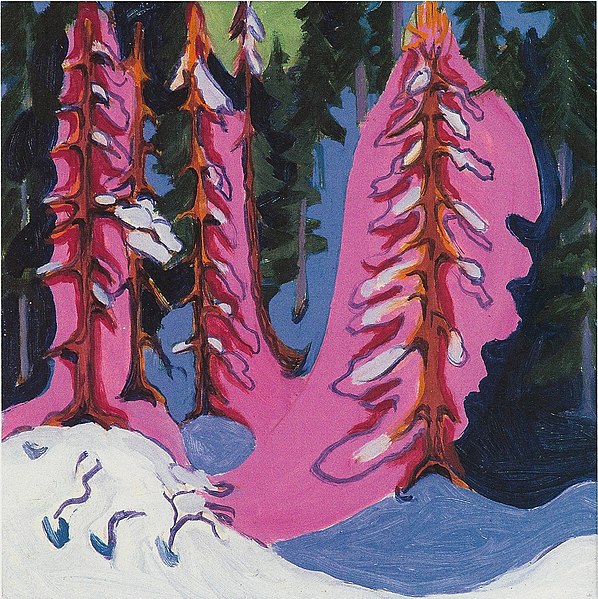.
At the Forest Edge: Ernst Ludwig Kirchner (1880-1938), 1935-36 (Kunsthaus Glarus)
Close your eyes you can almost hear it, the low hum of the gone hiding
under the ground mixing in with the highpitched sounding of the yet unborn
still planted deep in the future. This wordless anthem or hymn sempiternal
works on you like a kind of spell, keeping you in the breath-thrall of the living
for now.
under the ground mixing in with the highpitched sounding of the yet unborn
still planted deep in the future. This wordless anthem or hymn sempiternal
works on you like a kind of spell, keeping you in the breath-thrall of the living
for now.

I have a few books on Kirchner, some of his writings, etc, but I had never seen these. lovely text tom.
ReplyDeleteThanks mucho Lanny. These Kirchner works really speak. He did so very much great work, much goes unseen. What confidence he has to overpaint with colours no one would ever use. The ice cream of a jagged darkness. Some paintings look to have been done extremely quickly, gestural.
ReplyDeleteYes, amazing work -- thanks Tom for these treasures.
ReplyDeletethe purple and pink shades are my favourite...!
ReplyDeleteReading these poems and seeing these Kirchners on the drive to NY today, while taking a break from the work I was doing, was extraordinary. Being busy with other things for a long time had almost stolen my memory of how great Kirchner's work is, both the paintings containing people (which have extraordinarily acute psychological dimensions because of the way the figures are drawn, how they are placed and the colors) and the landscapes. The poems are matches for me – from acute, intense moment to acute, intense moment. “The low hum of the gone hiding.”
ReplyDeleteI reminded myself of the details of Kirchner’s life and remembered his beautiful, intelligent face. When I learned about the Kirchner Museum in Davos, I became interested in learning whether or not the World Economic Forum had yet co-opted it as a cocktail party site. Haven’t gotten to the bottom of that one yet, but I did find this fascinating Swiss News article about Kirchner’s final days:
www.highbeam.com/doc/1G1-188273866.html
Two interesting excerpts were:
“Schick and Augustin agree that Kirchner got on well with local farmers, even if most of the mountaineers seemed baffled by his choice of colours. On occasion, Augustin recalls, the artist would offer a farmer one of his paintings as a gift. It would represent a fortune on today's market. But the farmer would often say, "No thank you". He knew, after all, that cows were brown, not pink or purple.”
and
"It took Nolde a long time to see through the Nazis," she points out. "Kirchner understood what they stood for at first contact. He had good reason for feeling paranoid about them. Above all, he wanted to be left in peace."
Wow. Speechless at this beauty.
ReplyDeleteThank you Stephen, Sandra, Curtis, Anonymous.
ReplyDeleteSandra, yes, this work rescues the reputation of purple and pink forever (at least for us).
Yes, Curtis, as Nolde understood, Kirchner's paranoia about the Nazis proved all too perfectly sensible in the event. His work was declared verboten from 1933 on, and his suicide in 1938 and the subsequent dispersal of his works can surely attributed to his being caught up in that historical wave of horror.
Once again, somebody gained in the long run. I seem to recall one of the 1913 Berlin street scenes going at auction for 58 million. While, as you say, in his final years Kirchner had a hard time giving his work away.
i hear it
ReplyDeletebreathing
i breathe
it hears me
Hb
ReplyDeleteI see those pink trees in the lower image as lungs, breathing.
for now is an excellent mantra
ReplyDeleteloved "planted deep in the future"
closing my eyes so I can almost hear it
otto,
ReplyDeleteclosing my eyes so I can almost hear it with you